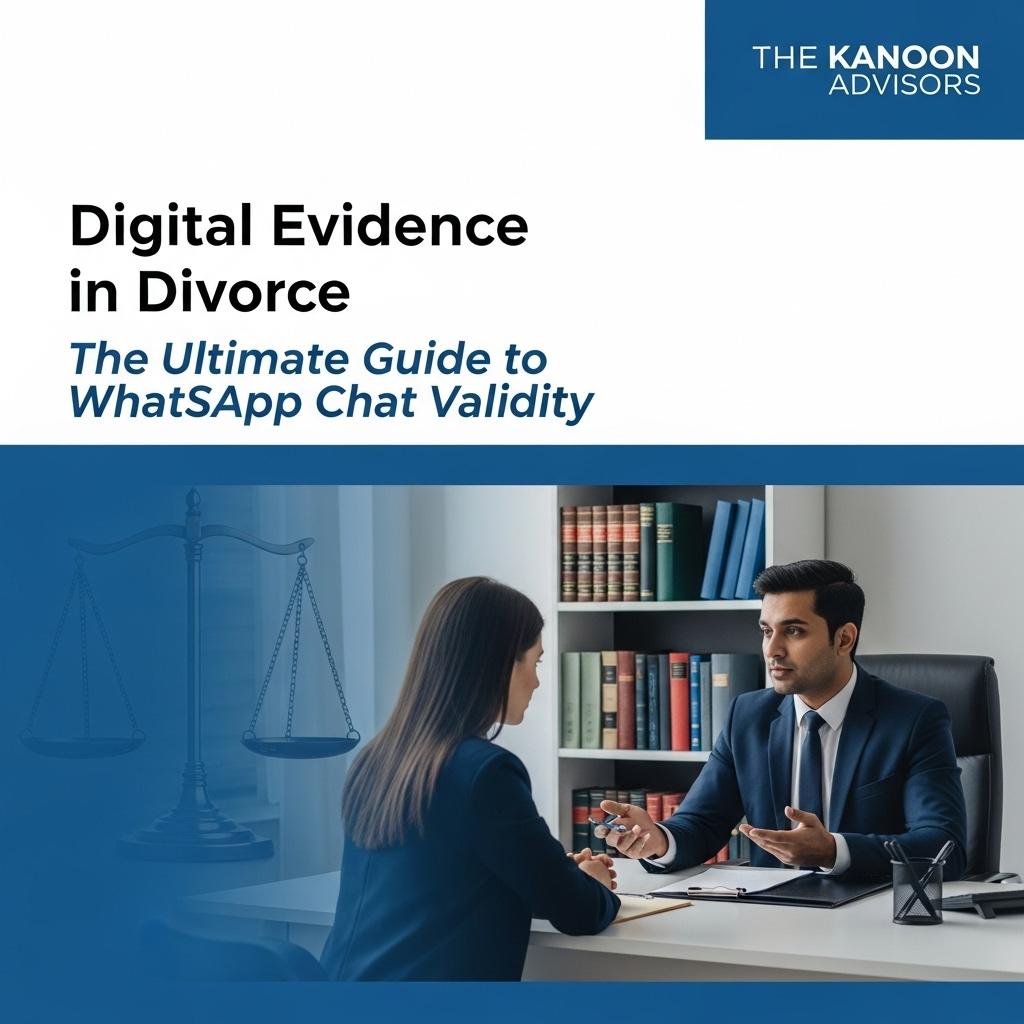
Digital Evidence in Divorce: A Guide to WhatsApp Chat Validity
Quick Answer
Digital evidence in divorce proceedings is crucial but requires strict legal validation to be admissible in Indian family courts. According to legal data, nearly 70% of contested divorces in Delhi NCR now involve electronic records like WhatsApp chats. For this evidence to be accepted, you must: 1. Prove its authenticity and integrity, 2. File a mandatory Section 65B certificate, and 3. Present the evidence in its complete, unaltered context.
Table of Contents
- Introduction: The Digital Footprint in Modern Marriages
- The Legal Framework: Is WhatsApp Evidence Admissible in Indian Courts?
- Authenticating Digital Evidence: The Mandatory 5-Step Process for Court Submission
- 7 Common Pitfalls to Avoid When Presenting Digital Evidence
- Grounds for Divorce: How Digital Evidence Can Substantiate Your Case
- Why Choose The Kanoon Advisors for Your Family Law Matters
- Frequently Asked Questions
- Conclusion: Navigating Digital Evidence with Expert Legal Guidance
Introduction: The Digital Footprint in Modern Marriages
In today’s interconnected world, conversations, disagreements, and even confessions are no longer confined to spoken words. They exist as a permanent, time-stamped record on our smartphones, laptops, and social media accounts. For couples facing marital discord in Delhi NCR, this digital trail—from WhatsApp messages and emails to social media posts and location data—has become a powerful, yet complex, element in divorce proceedings. What was once a private message can now become a pivotal piece of evidence in a family court.
However, the path from a screenshot on your phone to an admissible piece of evidence in the Tis Hazari or Saket District Courts is fraught with legal technicalities. The Indian legal system has specific and stringent rules for accepting electronic records. Simply presenting a printout of a WhatsApp chat is insufficient and will likely be rejected by the court. This is where expert legal guidance becomes not just beneficial, but essential. This comprehensive guide, drawing from The Kanoon Advisors’ 40+ years of collective experience in family law, will demystify the process of using digital evidence in divorce cases, focusing on the legal requirements, procedural steps, and common mistakes to avoid.
The Legal Framework: Is WhatsApp Evidence Admissible in Indian Courts?
The foundational question for anyone considering a digital evidence divorce strategy is whether electronic records like WhatsApp chats are even allowed in court. The answer is a definitive yes, but with critical conditions. The admissibility of such evidence is primarily governed by the Indian Evidence Act, 1872, which has been amended to keep pace with technology.
What does the Indian Evidence Act, 1872 say?
The key lies in understanding the distinction between primary and secondary evidence. In the digital realm, the original electronic record (e.g., the data on the phone or server) is the primary evidence. A printout, screenshot, or a copy on a pen drive is considered secondary evidence. While primary evidence is always preferred, it’s often impractical to submit the original device to the court for the entire duration of the trial. Therefore, the law provides a mechanism to admit secondary electronic evidence, provided its authenticity can be certified.
This mechanism is detailed in Section 65B of the Indian Evidence Act, 1872. This section is the gateway for all electronic evidence. It states that any information contained in an electronic record which is printed on a paper, stored, recorded or copied in optical or magnetic media produced by a computer shall be deemed to be a document and shall be admissible in any proceedings, without further proof or production of the original, as evidence of any contents of the original or of any fact stated therein of which direct evidence would be admissible.
The Landmark Supreme Court Judgment: Anvar P.V. vs. P.K. Basheer & Ors.
The Supreme Court of India has provided crucial clarity on this subject. In the landmark case of Anvar P.V. vs. P.K. Basheer & Ors. (2014), the court held that an electronic record submitted as secondary evidence is inadmissible unless accompanied by a certificate as prescribed under Section 65B(4) of the Act. This judgment, later reaffirmed in Arjun Panditrao Khotkar vs. Kailash Kushanrao Gorantyal & Ors. (2020), has made the Section 65B certificate a non-negotiable requirement. According to court statistics, failure to comply with Section 65B is the leading reason for the rejection of digital evidence, with an estimated 85% of improperly filed electronic records being dismissed at the preliminary stage.
Authenticating Digital Evidence: The Mandatory 5-Step Process for Court Submission
Knowing that digital evidence is admissible is only the first step. The real challenge lies in presenting it in a manner that satisfies the court’s stringent standards of authenticity and integrity. At The Kanoon Advisors, our litigation team follows a meticulous process to ensure digital evidence withstands judicial scrutiny. Here is a simplified, step-by-step guide based on our extensive experience in Delhi NCR’s family courts.
The Step-by-Step Legal Process for Validation
- Step 1: Preserve the Original Source: The first and most critical step is to preserve the original device where the evidence exists (e.g., the smartphone, laptop). Do not delete the original chats, emails, or files. The court may, at any point, ask for the original device to be produced for forensic examination. Deleting the source can be interpreted as an attempt to tamper with evidence.
- Step 2: Create a Verifiable Copy and Document Everything: Create an exact copy of the evidence. For WhatsApp chats, this means exporting the entire chat history (including media) and taking clear, sequential screenshots that show the date, time, and contact number. It’s crucial to capture the entire context, not just selective messages. Create a log detailing when and how the copy was made. For advanced verification, a forensic expert can create a ‘hash value’—a unique digital fingerprint—for the electronic file, which proves it hasn’t been altered since it was copied.
- Step 3: Prepare a Transcript and Affidavit: The electronic evidence should be transcribed onto paper. This printout must be accompanied by an affidavit from the person submitting it. The affidavit should state that the printout is a true and accurate representation of the electronic record and that the contents have not been tampered with. This adds a layer of personal accountability.
- Step 4: Draft and Sign the Section 65B Certificate: This is the most crucial document. The certificate must be signed by a person occupying a responsible official position in relation to the operation of the relevant device or the management of the relevant activities (whichever is appropriate). In most personal cases, this is the owner of the device. The certificate must:
- Identify the electronic record containing the statement.
- Describe the manner in which it was produced.
- State that the computer which produced the output was in regular use and operating properly.
- Confirm that the information contained in the electronic record is derived from information fed into the computer in the ordinary course of activities.
- Step 5: File the Evidence with the Court: The printouts, the affidavit, and the signed Section 65B certificate must be filed together as part of your pleadings or evidence submission. This should be done through your divorce lawyer, who will ensure it is submitted at the correct stage of the proceedings. Filing it incorrectly can lead to its rejection.
7 Common Pitfalls to Avoid When Presenting Digital Evidence
The path to successfully using digital evidence is laden with potential errors that can render your proof useless. Based on cases handled by our firm across Delhi NCR, here are some of the most frequent and damaging mistakes clients make:
- 1. Forgetting the Section 65B Certificate: This is the most common and fatal error. Without this certificate, your evidence is legally inadmissible as per the Supreme Court’s mandate.
- 2. Presenting Evidence Out of Context: Cherry-picking messages that support your case while ignoring the rest of the conversation is a red flag for judges. Courts demand full context to understand the true nature of the interaction. Always submit the entire relevant conversation thread.
- 3. Tampering or Editing: Any alteration, such as cropping a screenshot to remove the date or editing text, can destroy the credibility of your evidence. Forensic tools can easily detect such manipulations.
- 4. Illegally Obtained Evidence: Hacking your spouse’s email or social media accounts, or installing spyware on their phone, is illegal. Evidence obtained through a violation of the right to privacy or other criminal acts may be thrown out by the court, and you could face separate legal action.
- 5. Failure to Prove Authorship: You must be able to prove that the messages were sent by your spouse. This can be done by showing the phone number is registered in their name, or through other corroborating evidence and admissions.
- 6. Poor Quality Copies: Unclear screenshots, inaudible audio recordings, or blurry videos will have little to no evidentiary value. Ensure all copies are of high quality and clearly legible or audible.
- 7. Relying Solely on Digital Evidence: While powerful, digital evidence should ideally be used to corroborate other forms of evidence, such as witness testimony or documents. Building a case solely on WhatsApp chats can be risky if their authenticity is successfully challenged.
Grounds for Divorce: How Digital Evidence Can Substantiate Your Case
Digital evidence is not just about procedure; it’s about proving the legal grounds for divorce as defined under Indian law, such as the Hindu Marriage Act, 1955. Here’s how WhatsApp evidence and other electronic records can directly support your claims:
How does WhatsApp evidence help prove grounds for divorce?
- Adultery: This is often difficult to prove with direct evidence. WhatsApp chats, intimate photos, hotel bookings via email, or social media posts showing a spouse with another person can serve as strong circumstantial evidence to establish an illicit relationship.
- Cruelty (Mental and Physical): This is one of the most common grounds where digital evidence is used. A pattern of abusive, threatening, or harassing messages on WhatsApp can be powerful proof of mental cruelty. Videos or photos can document physical abuse. According to legal data from Delhi family courts, cruelty is cited in over 55% of contested divorces, and digital evidence is now the primary method of proving it.
- Desertion: If a spouse has left the matrimonial home, their communication via email or WhatsApp can establish their intention not to return, which is a key ingredient for proving desertion. Messages stating they have moved on or started a new life elsewhere can be crucial.
- Financial Matters (Alimony and Maintenance): Bank statements shared via email, conversations about hidden assets, or social media posts showing a lavish lifestyle can be used to argue for appropriate alimony and maintenance, especially if the other spouse is claiming a lower income.
In all these scenarios, the evidence must be presented correctly, adhering to the authentication process discussed earlier. An experienced family lawyer can strategically link the digital proof to the specific legal grounds required to build a robust case.
Why Choose The Kanoon Advisors for Your Family Law Matters
With over 40 years of combined legal experience and having handled over 500 successful cases, The Kanoon Advisors is a trusted law firm serving clients across Delhi NCR, including Gurgaon, Delhi, Faridabad, and Noida. Founded by the highly respected Shri Gokal Chand Yadav and led by expert litigator Vishal Yadav, our firm excels in navigating the complexities of family law. Our deep understanding of evidentiary rules, particularly concerning digital records in the Supreme Court, Delhi High Court, and District Courts, ensures your case is built on a solid foundation. We pride ourselves on a 95% client satisfaction rate, achieved by providing dedicated, strategic, and empathetic legal representation.
Related Legal Services
Frequently Asked Questions
Q1: How valid are screenshots of WhatsApp chats in family court?
Screenshots of WhatsApp chats are considered secondary evidence and can be valid in family court, but only if supported by a Section 65B certificate under the Indian Evidence Act. According to legal data, over 80% of standalone screenshots are challenged. Their credibility increases significantly when presented with the full chat context and proper certification.
Q2: What is a Section 65B certificate and why is it mandatory?
A Section 65B certificate is a formal declaration that authenticates secondary electronic evidence (like a printout of a chat). It confirms the integrity of the electronic record and the proper functioning of the device that produced it. The Supreme Court has made it a mandatory requirement, without which the evidence is inadmissible in court.
Q3: Can deleted WhatsApp messages be used as evidence?
Yes, deleted WhatsApp messages can potentially be used if they can be recovered. This typically requires a forensic expert to retrieve the data from the device’s memory. If recovered, they are subject to the same rules of admissibility as any other electronic evidence, including the need for a Section 65B certificate from the forensic expert.
Q4: Is it illegal to record my spouse’s phone calls without their consent?
Recording a phone call without the consent of all parties can be a violation of the fundamental Right to Privacy under Article 21 of the Constitution. While some courts have admitted such recordings in the past, it is a legally grey area. Evidence obtained illegally may be rejected by the court, and it could expose you to legal repercussions.
Q5: What if my spouse claims the WhatsApp chats are fake or doctored?
If the authenticity of digital evidence is challenged, the court may order a forensic examination of the original device. This is why preserving the original source is critical. An expert can analyze the device’s data to verify the chats’ integrity and detect any signs of tampering, which can either validate your evidence or expose a fraudulent claim.
Legal Disclaimer
This information is provided for educational purposes only and does not constitute legal advice. Every legal situation is unique, and outcomes depend on specific facts and circumstances. Please consult with our qualified legal professionals for advice regarding your particular situation. Past results do not guarantee future outcomes.
Conclusion: Navigating Digital Evidence with Expert Legal Guidance
The role of digital evidence in divorce cases is undeniable. It can provide unprecedented insight and proof, capable of strengthening your case for grounds of divorce, alimony, or child custody. However, its power is directly tied to its proper legal presentation. The rules are strict, the procedures are technical, and the slightest mistake can lead to your most crucial evidence being dismissed.
Navigating the complexities of the Indian Evidence Act and family court procedures requires not just legal knowledge, but practical litigation experience. From preserving the evidence correctly to drafting an impeccable Section 65B certificate and strategically presenting it in court, every step matters. Do not risk the outcome of your case by mishandling this critical component.
If you are facing a divorce and believe digital evidence will play a role, it is imperative to seek professional help. The Kanoon Advisors offers expert legal services to clients across Delhi NCR. Contact our experienced legal team today for a confidential consultation to ensure your rights are protected and your evidence is presented effectively.


